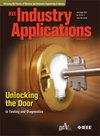An Ultra-Lightweight PM Electrical Motor for High-Altitude Platform Applications
IF 4.5
2区 工程技术
Q2 ENGINEERING, ELECTRICAL & ELECTRONIC
引用次数: 0
Abstract
This paper describes key aspects of the development process of an ultra-lightweight electrical motor for solar-powered high-altitude (20 km) platform applications (HAPSs). A radial-flux permanent magnet (PM) machine topology with outer rotor and integrated direct air-cooling is considered here. The mission profile of the analysed solar-powered aircraft calls for a high-torque overload (×2.5) at take-off and a high-efficiency (>95%) at high-altitude cruise operation. Consequently, a fine balance between both operating points needs to be seen when sizing the motor. Effective thermal management of the motor at take-off is critical for achieving a compact motor design. Further to these, the motor design should enable a simple and cost-effective manufacturing and sassembly process, which makes use of the lightweight composite materials for all structural elements of the motor assembly. In this work, a careful integration between both active and structural subassemblies of the motor resulted in a significant weight reduction, with contribution of all structural components less than 5% of the overall motor weight. The theoretical and experimental results discussed in the paper confirm the key design targets of the motor are met, with a motor torque density of 10Nm/kg (take-off operation) and 94% efficiency (cruise operation). Further to the motor development process, a comprehensive insight into the existing state of the art HAPS solar-powered aircrafts with focus on the commercial electrical motor technology and motor to aircraft integration is provided to highlight some of the application driven engineering challenges.一种用于高空平台的超轻型永磁电机
本文描述了用于太阳能高海拔(20公里)平台应用(HAPSs)的超轻型电动机开发过程的关键方面。本文考虑了一种具有外转子和集成直接空冷的径向磁通永磁(PM)拓扑结构。所分析的太阳能飞机的任务要求在起飞时具有高扭矩过载(×2.5)和在高空巡航操作时具有高效率(>95%)。因此,两个工作点之间的一个良好的平衡需要看到时,大小电机。发动机起飞时有效的热管理对于实现紧凑的发动机设计至关重要。此外,电机的设计应使制造和装配过程简单且具有成本效益,这使得电机组件的所有结构元件都使用轻质复合材料。在这项工作中,电机的主动组件和结构组件之间的仔细集成导致了显著的重量减轻,所有结构组件的贡献不到电机总重量的5%。理论和实验结果表明,该电机达到了主要设计目标,起飞工况下电机转矩密度为10Nm/kg,巡航工况下电机效率为94%。在电机开发过程中,对现有最先进的HAPS太阳能飞机进行了全面的了解,重点关注商用电机技术和电机与飞机的集成,以突出一些应用驱动的工程挑战。
本文章由计算机程序翻译,如有差异,请以英文原文为准。
求助全文
约1分钟内获得全文
求助全文
来源期刊

IEEE Transactions on Industry Applications
工程技术-工程:电子与电气
CiteScore
9.90
自引率
9.10%
发文量
747
审稿时长
3.3 months
期刊介绍:
The scope of the IEEE Transactions on Industry Applications includes all scope items of the IEEE Industry Applications Society, that is, the advancement of the theory and practice of electrical and electronic engineering in the development, design, manufacture, and application of electrical systems, apparatus, devices, and controls to the processes and equipment of industry and commerce; the promotion of safe, reliable, and economic installations; industry leadership in energy conservation and environmental, health, and safety issues; the creation of voluntary engineering standards and recommended practices; and the professional development of its membership.
 求助内容:
求助内容: 应助结果提醒方式:
应助结果提醒方式:


